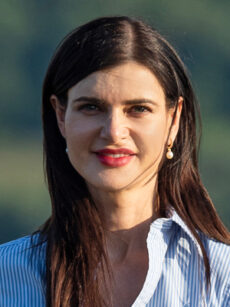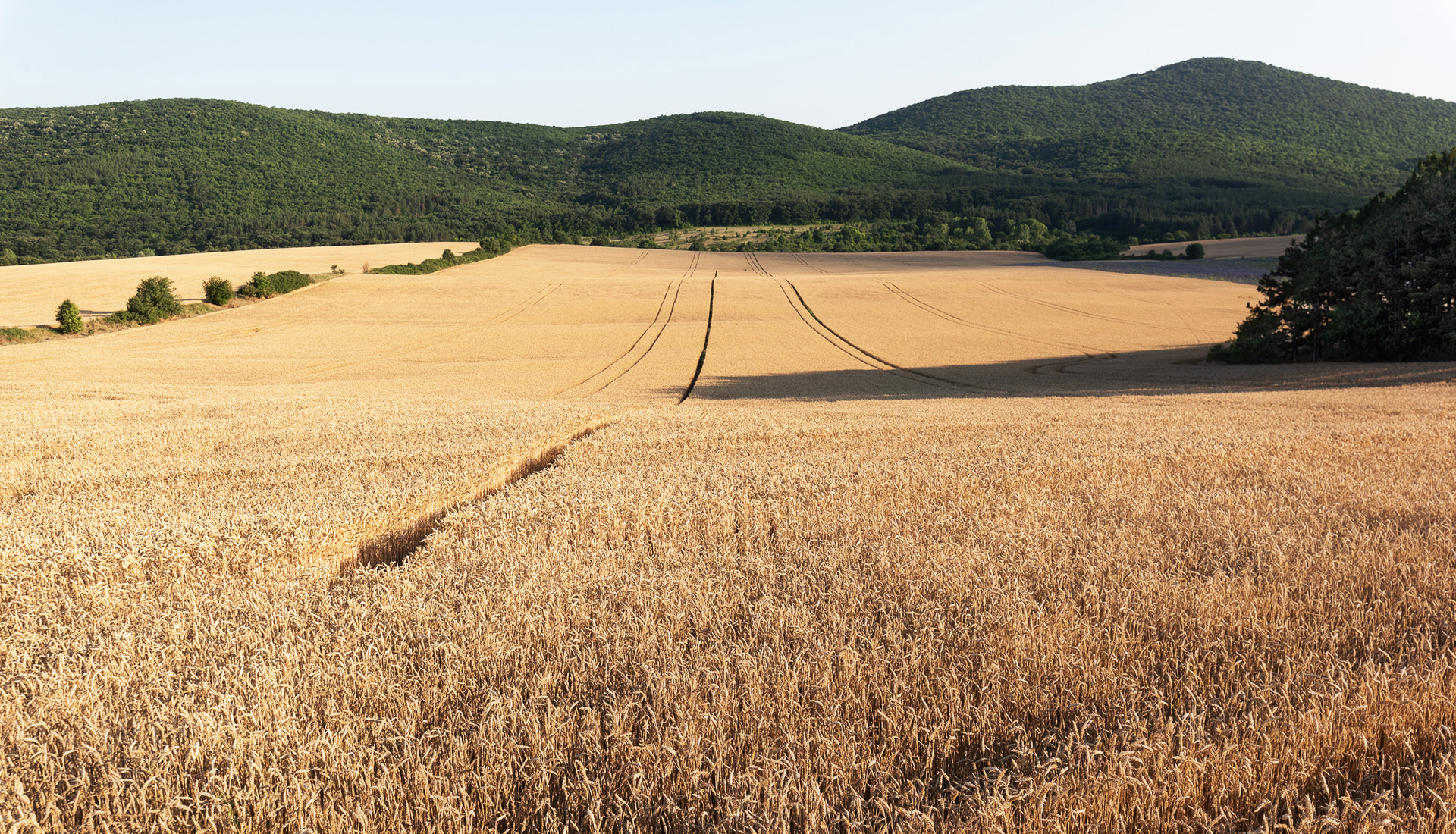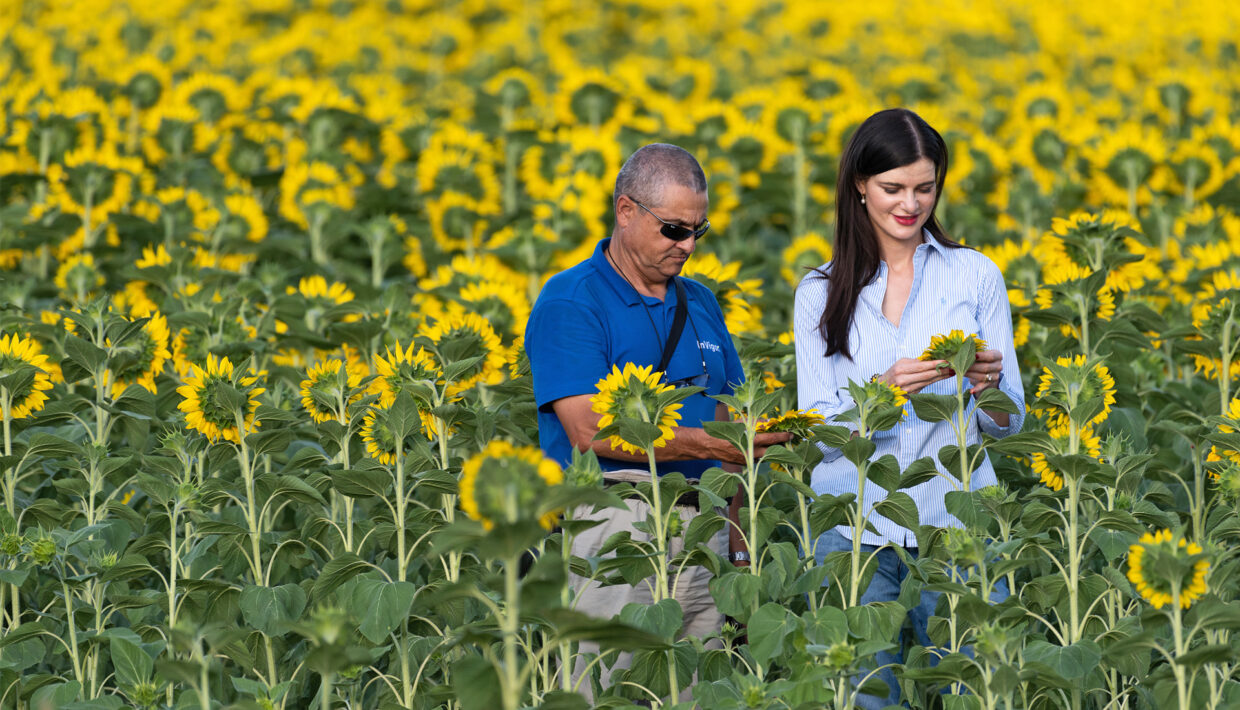Today the fields get inspected. Galina Peycheva-Miteva drives from Plovdiv out into the Bulgarian countryside towards the small town Malko Dryanovo, where most of the fields she manages are located. She goes to the office, checks the mail, the orders, deliveries, and harvest plans. There is quite a lot of administration required to properly manage 1,200ha of land. Then she goes out to the field where she meets up with her two agronomists. Together they survey the sunflowers and wheat fields and plan the impending harvest.
Mrs. Peycheva-Miteva has been running the farm for almost 15 years. She came to this position by chance – with hardly any formal agricultural training. “I helped out on our farm in the summer of 2008 and was preparing to apply for a job in finance – my big dream at that time. Then our operations manager resigned, and we urgently needed a replacement. I was just filling in for the time being.”

Galina Peycheva Miteva, farmer and manager
I was just filling in for the time being.
Galina Peycheva-Miteva
This temporary solution turned into a career path: As well as working full-time on the farm, she is, among other things, also involved on the board of the European Landowners’ Organisation, lectures in Brussels and speaks about the opportunities regenerative agriculture provides.
Regenerative and successful
Mrs. Peycheva-Miteva also implements a regenerative agriculture approach on her farm, which stretches across 1,200ha. In Bulgaria there are many farms managing more than 2,000ha, so her enterprise is a medium sized operation. The crop portfolio is diverse: Annual and perennial crops, both conventional and organic. She grows the traditional crops of the region: Wheat, barley, rapeseed, and sunflowers, but also alfalfa, coriander, milk thistle and grass mixtures.
The farm also has vineyards, a rose garden, and lavender fields. She sells most of the crops regionally after harvest; alfalfa and grass mixtures are used as animal feed for surrounding farms and the grapes from the 62ha vineyard are processed by some of Bulgaria’s leading vine makers about 40km away. The cultivation of roses and lavender is also common for the region.

Galina Peycheva-Miteva grows her wheat following regenerative farming practices.
“Bulgaria is well known for its rose oil,” she explains. “However, it takes a lot of petals to produce even a small amount of essence, which makes natural rose oil expensive. That means it is mainly used in high-quality perfumes, therefore demand fallen sharply,” she adds. However, that is not the case for the inhabitants of the expansive rose fields on site: Approximately 700 surrounding beehives are still very happy about the flower supply. And so are the neighbouring beekeepers, who produce regional honey with the help of their bees.
The organically grown high-value crops also include milk thistle. “Growing thistles has a long tradition in our region. The thistles we grow are mainly used to produce a liver medicine but also for cold pressed oil, which is used for liver treatments as well. The oil is a powerful liver detox agent, and it is very popular ingredient not only in conventional medicine but also in homeopathy and alternative treatment medicine.”
Mrs. Peycheva-Miteva also grew cotton on the farm for several years, but this had to be abandoned due to increasingly cold and wet springs, which caused many problems for the crop.
Challenging extremes of climate change
The farm is increasingly being confronted with constantly evolving challenges, due to climate change. “This year it has been extremely hot and dry with almost 40⁰C in June,” she says. “In 2021, on the other hand, it was rainy and cold.” It is hard to deal with such rapidly changing conditions. Above all, she cannot rely on the weather patterns of recent years which makes yield planning difficult – a supposed formula for success can become obsolete after just one year.
The soil also suffers from the climatic conditions, and it was not particularly good when Galina Peycheva-Miteva started thinking about making changes. “From a depth of 15cm, the soil was like concrete – much too compacted and salty. The crops did not root well, and the soil was barely able to protect itself against erosion by wind and weather.”
To counteract this and increase the soil quality in the long term, Mrs. Peycheva-Miteva first introduced a multi-structured crop rotation and different catch crops, as well as minimal tillage. This means the soil is covered throughout a longer period of the year, it can be better penetrated by roots, harvest is spread over the year and the soil is less stressed.
We look at our most important production resource – in this case the soil and its health – from a long-term perspective.
Galina Peycheva-Miteva
Bacteria instead of fertiliser
After harvest, straw is worked into the soil, preserving its organic matter, and protecting it from erosion. Additionally, shallow tillage stimulates weed germination, making them easier to control. Mrs. Peycheva-Miteva also started adding different microorganisms to the soil, which can bind nitrogen and phosphorus. These increase productivity and restore the natural soil properties. She also used bacteria that can destroy disease pathogens. All of this, in turn, leads to significantly less fertiliser being used – which benefits the soil in the long run.

Milk thistle seed are dried in the sun and turned by hand.
Mrs. Peycheva-Miteva experimented with the amount and type of additives for a long time until she developed a balanced system that worked. “It would be a lie to say that everything we tried worked the same or was a spectacular success,” she says. But it all paid off as in 2017, she was awarded the Land and Soil Management Award for her approach to promoting soil quality.
Adding different bacteria led to a visible improvement in soil quality: More worms, more oxygen, healthier root systems – and yields as high as before starting the new practices. This is a complete success, not only as a farmer, but also as a businesswoman. By saving on fertiliser, Miss Peycheva-Miteva can quickly recoup the additive costs. “Regenerative agriculture is a complete economic success, with many positive, sustainable effects,” she says.
For me, regenerative agriculture is not only an ecological success, but an economic one as well.
Galina Peycheva-Miteva
Agriculture can be more precise
When switching to minimum tillage, the right machines also play a role. “Reliable tractors are needed for this task – that’s why I decided on a John Deere,” she explains. This has laid the foundation for the future, in which she wants to focus on precision agriculture, particularly as no two hectares of soil are alike. “The wealth of data we can collect thanks to precision farming allows us to develop a customised approach. We also achieve huge savings and even better results this way.”

Galina Peycheva-Miteva was awarded the Land and Soil Management Award for her system to improve soil quality.
Miss Peycheva-Miteva is keen to share the experience she has gained over the years with soil bacteria and climate change, particularly in her region. “Most farmers don’t want to read long scientific reports, they just want to know what they can do on a day-to-day basis. We need to network more regionally and personally.” As the climatic challenges in the region are comparable, everyone can benefit from an open exchange here.
She looks at the bright yellow field full of sunflowers. “This is our land – whoever owns it has to take care of it. For me, there can only be long-term and sustainable land management.”




